|
Reviews
and Articles
About
Native Canadian Artist Darlene Gait
From Canadian Brushstroke Magazine, March/April 2008
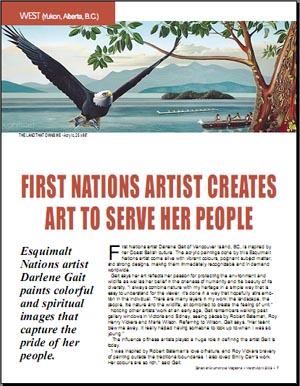
First Nations Artist Creates Art to
Serve Her People
Esquimalt Nations artist Darlene Gait paints colorful and spiritual
images that capture the pride of her people.
First Nations artist Darlene Gait of Vancouver Island, BC, is inspired
by her Coast Salish culture. The acrylic paintings done by this
Esquimalt Nations artist come alive with vibrant colours, poignant
subject matter, and strong designs, making them immediately recognizable
and in demand worldwide.
Gait says her art reflects her passion for protecting the environment
and wildlife as well her belief in the oneness of humanity and the
beauty of its diversity. I always combine nature with my heritage
in a simple way that is easy to understand for the viewer. It's
done in a way that hopefully stirs emotion in the individual. There
are many layers in my work: the landscape, the people, the nature
and the wildlife, all combined to create the feeling of a unit.
Noticing other artists' work at an early age, Gait remembers walking
past gallery windows in Victoria and Sidney, seeing pieces by Robert
Bateman, Roy Henry Vickers and Marla Wilson. Referring to Wilson,
Gait says, "her talent blew me away. It really helped having
someone to look up to when I was so young. "
The influence of these artists played a huge role in defining
the artist Gait is today.
I was inspired by Robert Bateman's love of nature, and Roy Vickers'
bravery of painting outside the traditional boundaries. I also loved
Emily Carr's work. Her colours are so rich, said Gait.
Another prodigious factor in Gait's artistic and creative development
was her grandmother, Hilda Cooper. "My grandmother was a medicine
woman, a real medicine woman. I want to make that clear," she
insists. "People would seek her out and pay her well to make
their problems go away. Not just marital or health problems, but
she even had a talent for quickly getting people out of jail when
needed," according to Gait. ... see full
story PDF format

Esquimalt artist Darlene Gait's paintings
honor, promote healing
Posted: January 23, 2008
by Richard Walker / Indian Country Today
ESQUIMALT, British Columbia - Connection. That's the golden thread
woven through all of Esquimalt artist Darlene Gait's paintings and
screenprints.
Her art is varied in style as well as subject. ''Spawning,'' an
ink and colored-pencil depiction of salmon spawning, brings to mind
the work of Musqueam artist Susan Point. Several of Gait's mixed
media and acrylics - like ''Alert Bay,'' ''Connections,'' ''Legends''
and ''Wisdom from Above'' - are reminiscent of Tsimshian/Haida/Heiltsuk
artist Roy Henry Vickers.
But her work is uniquely personal, inspired by her connection to
the environment and wildlife as well as her belief in the oneness
of humanity and the beauty of its diversity.
Gait, 39, is as inspired as she is inspirational. One night, in
her husband's native Spain, she had a dream about the connectedness
of people and other living things. The next morning, she was praying
on the balcony of her room and a hawk landed on her head. She and
her husband studied the bird, which mimicked their head movements.
That encounter led to ''Balance,'' an acrylic on canvas.
''It has always been a difficult challenge to find a balance mentally,
physically and spiritually, and it has been a lifelong goal of mine
to have that, and I remember this dream I had with the feeling of
finding that balance and it was so incredible,'' she wrote about
the piece. ''I tried to illustrate that in this painting.''
In her wildlife art, prominent animals of the Northwest Coast -
bear, eagle, raven, salmon - are depicted from encounters she has
had with them in their environment. She incorporates Coast Salish
elements to illustrate the interdependence of her culture and the
environment.
In ''Blue Moon,'' Gait honors her maternal grandfather, who died
before she had the opportunity to know him.... full
story
Cover Story from FOCUS Magazine October, 2007
Darlene Gait:
LISTENING TO HER DREAMS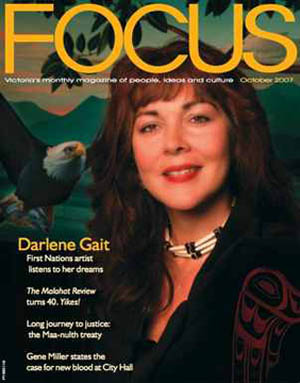
By Linda Rogers
Click to download PDF
Version
I arrive a day early for my meeting with Darlene Gait at her new
One Moon Gallery on the Esquimalt Reserve. It is a sunny afternoon,
so I explore the beautiful cove in front of the Big House and band
office. Seagulls scold mother eagles circling the water’s
edge with their young, teaching them how to hunt. On the beach,
stone benches circle a fire. The peace is palpable.
A day later, Darlene and I meet in the parking lot. When she takes
me into the gallery she opened in April 2007, I am struck at first
by the mingling scents of cedar and artist’s materials.
Even though I know I am imagining the smell of oil paint, as Darlene
works in acrylic and takes prints from her originals, memory insists.
She gives me a tour of the work on her walls. The limited-edition
giclee prints on canvas or archival paper are to scale with the
paintings which, she says, are almost indistinguishable from the
originals. “I learned that some reds are not easily reproduced,
but otherwise the color is very faithful.” By reproducing
her technically accomplished dream works at the source, the painter
has control. I think of other artists, in particular Salvador
Dali, whose print works have been desecrated by sloppy reproduction.
Converting paint to print is an important statement. It democratizes
Gait’s highly individual style. She wants her work, which
hangs in ordinary homes as well as galleries like the Metropolitan
Museum of Art, the Guggenheim Gallery and the Smithsonian Museum,
to be accessible.
“I was destined to be an artist,” she says, “even
though my father was concerned that I might not be able to earn
a living.” Darlene’s other aptitudes, for science and
archeology, are manifested in her astonishingly accurate detail
and her respect for antiquity. Her father’s anxiety has been
answered in her ability to maintain artistic integrity in the marketplace.
“My two sisters and my brother have followed their dreams
as well. We were taught self-respect and respect for our Native
heritage.”
Upstairs from the One Moon Gallery is her parents’ new home.
Because her father is of European ancestry and her mother is from
the Esquimalt Nation, Gait grew up feeling as if she were straddling
continents. Now they are at home together: her family, her Nation
and her work, a co-existence which is her model for the world.
Married after completing high school in Errington and a mother
before the end of her second decade, Gait has had to struggle. Left
on her own with a child to raise, she worked at jobs that put food
on the table, painting at night when her first son, Justin, now
going to film school, was asleep. “Those were hard years,
but I persevered, teaching myself technique and listening to my
dreams.”
Gait explains that she works from text rather than image. A voice
will speak to her. It may be embedded in memory or suggested by
objects in the phenomenal world. Transferring words into visual
images is her way of storytelling. And those stories are very powerful.
Taking traditional emblems, such as animals with supernatural
associations, she transfers their power into contemporary moments,
often the narratives of children coming to terms with history. In
one painting, her youngest son, Jonah, sits with a book on the steps
of the Legislature in Victoria, absorbing the information that his
ancestors once lived on land now covered with fussy Victorian architecture.
When Gait met and married her current husband, Mark, who had already
collected some of her work—falling in love with the art before
he’d met the artist—she studied and later embraced the
Bahá’í faith. The serenity that comes from the
practice of meditation is evident in her peaceful transformations
of dream into reality. Despite the vividness of her color and the
clarity of her line, there is no harshness in the idealized natural
world she creates. The transformational power that allowed her aboriginal
ancestors to move in and out of the spirit realm is apparent in
the images she selects to tell her stories: animals with grace and
wisdom, children with genetic memory, and landscapes that are one
with plant and animal life.
I glance at a painting of eagles soaring past a mountain top. “Is
that from a dream?” I ask. No,” she laughs, “I
actually went there. I am not afraid of adventure. The scientist
in me wants to experience and record the real world.”
I quote what W. O. Mitchell said of writing novels: “The
details are true, their sum is fiction.” Gait is very exact
in reproducing the natural world. She could be a botanist. The effect
of her technique, however, is anything but static. It grows with
the spirit, just as she hopes the human race will evolve to living
as one family on the planet.
The Bahá’ís, like her mother’s matrilineal
culture, teach the equality of women. Gait says she has overcome
the “fear of success” that afflicts many women. That
fear, and some Native criticism of her work as “not traditional,”
made her early years difficult. “It especially hurt when I
watched a Cowichan mother’s dismissive refusal of her child’s
request for one of my small prints.” Meditation and the support
of her husband have helped her to accept and maintain her vision.
Evolution versus tradition is a perennial argument among aboriginal
artists, some of whom feel the only way to heal the traumas of history
is to adhere to the past. Darlene says, “We deserve to be
more than just the same. It needs to be OK to move ahead.”
Gait’s paintings, and her illustrations for children’s
stories published by Orca Books, are the emissaries she sends out
into a troubled world. She will be happy if she can help to facilitate
a reconciliation of her two solitudes, Native and non-Native. Her
work, her gallery and her beautiful presence, the Earth Mother Goddess
in many of her paintings, are evidence of hope.
Darlene’s work can be viewed at the One Moon Art Gallery
at 1192 Kosapsum Crescent, off Admirals, Esquimalt Nation. The Gallery
is open 10 a.m. to 5 p.m. Saturdays and Sundays. 250-294-6388
www.onemoon.ca.
Linda Rogers is working on the second and third books of her Victoria
trilogy. The first, The Empress Letters, will be featured
in Focus’ November edition.
|
From the Times Colonist, Thursday
October 2, 2003 Go! Art
INSPIRED BY
HER DREAMS
by Robert Amos
|
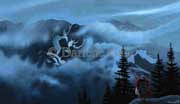 |
Darlene Gait’s art is about all things good. Her detailed
acrylic paintings are often narrative, with a poem attached, inspired
by her vivid dreams. They might feature a local animal imbued with
spiritual significance, totemic animals like eagle, wolf, heron,
kingfisher and lynx. With acrylic paint on canvas, she paints animals
and young women with every hair in place.
Children are often the subject of her pictures, as big-eyed and
charming as those of Dorothy Oxborough. There is a cosmic niceness
about her themes which brings to mind Roy Henry Vickers or Carol
Evans. Often the whole scene is bathed in a heavenly glow in the
mood of Thomas Kincaid.
Gait grew up at Errington near the Englishman River on Vancouver
Island. She is a member of the Esquimalt Band of the Coast Salish
Nation and lives in Shawnigan Lake. With a high level of skill and
encouragement, she seems poised for success in the wider world.
The current show is almost entirely made up of giclee prints of
her originals.
Indian Gaming
Magazine Cover Credits
 October,
2008 October,
2008 |
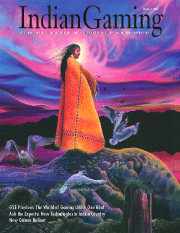 October
2007 October
2007 |
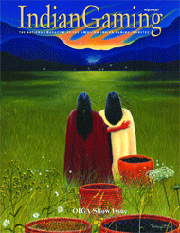 August
2007 August
2007 |
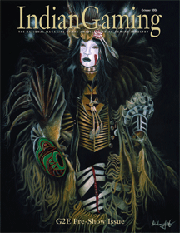 October
2006 October
2006 |
 March
2006 March
2006 |
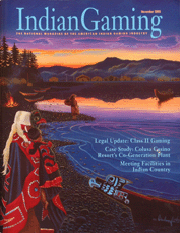 November 2005
November 2005 |
Indian
Gaming Magazine current issue
|




 October,
2008
October,
2008  October
2007
October
2007  August
2007
August
2007  October
2006
October
2006 March
2006
March
2006















